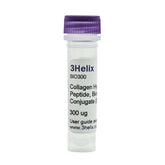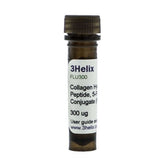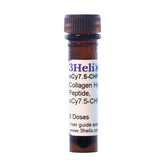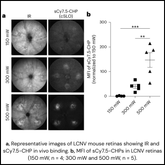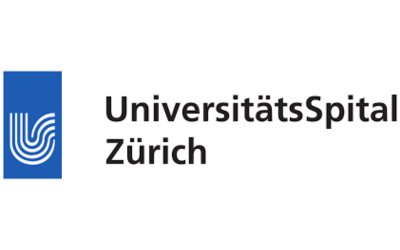Damaged collagen detected by collagen hybridizing peptide as efficient diagnosis marker for early hepatic fibrosis
Liver fibrosis, a significant pathological consequence of chronic liver disease and damage, is characterized by the excessive accumulation of extracellular matrix (ECM) proteins. This build up of non-functional scar tissue progressively replaces healthy tissue in the liver, leading to conditions such as cirrhosis, liver failure, and heightened risk of liver cancer. With a high prevalence in patients across disease groups, fibrosis is present in Non-Alcoholic Steatohepatitis (NASH), Alcoholic Liver Disease (ALD), viral hepatitis, and more. Current diagnostic and prognostic methods require histopathological biopsy analysis. Collagen, the primary protein of the ECM, is currently used as the biomarker for fibrosis levels. However, current diagnostic and prognostic liver biopsies only measure the amount or type of collagen present, frequently missing the collagen degradation and turnover present in early stage fibrosis. This paper proposes the use of Collagen Hybridizing Peptide (CHP), a histological stain specific for damaged collagen, to grade ECM remodeling in early stage disease.
Continue Reading
To test this, scientists compared the fibrotic detection capabilities of CHP and Sirius Red, the current fibrotic histology standard. After treating mice with either carbon tetrachloride (CCl4) or bile duct ligation (BDL) to induce fibrosis, liver biopsies were taken across a range of 2 to 14 days to capture development of fibrosis. A limitation of current diagnostic and prognostic tools is the inability to accurately grade early stage disease, which is a critical point for patients to begin lifestyle changes to slow disease progression. In this fibrosis model, CHP-positive staining could be detected as early as 3-7 days post injury. Critically, conventional Sirius Red staining, which detects total mature collagen deposition, only became observable after 14 days. As a dye-conjugated peptide that binds damaged or denatured collagen of any type, CHP staining provides a novel window into early disease activity. Unlike Sirius Red, which measures the quantity of deposited, intact collagen, CHP measures the quality of the collagen matrix revealing the sites of ongoing collagen damage, degradation, and subsequent remodeling. The image analysis showed that CHP staining was initially concentrated in the portal area, a key initiation site of fibrosis, later extending into the hepatic lobule following fibrosis progression. The presence of CHP was found to correlate with increased inflammatory cell infiltration, necrosis, and apoptosis. Proteomic analysis of the CHP-positive regions found that pathways related to ECM remodeling and fibrogenesis were significantly upregulated. This confirms that CHP has the ability to detect the pre-fibrotic active remodeling remodeling, the state before significant, visible collagen accumulation occurs.

(CHP) CHP staining is a superior and more sensitive diagnostic marker for early-stage hepatic fibrosis compared to a conventional Sirius Red stain. CHP detects active collagen damage and extracellular matrix (ECM) remodeling in liver tissue induced by both CCl4 (a) and BDL (b). Quantification data (n=6 per group, analyzed by Kruskal-Wallis or one-way ANOVA) shows significantly enhanced CHP staining at the very early stages of injury, confirming its ability to identify active disease prior to the accumulation of established collagen scarring detected by Sirius Red.
The ability to detect collagen damage and ECM remodeling at the earliest stages of fibrosis carries profound implications for clinical practice and patient care. An earlier, more accurate diagnosis enables healthcare providers to initiate anti-fibrotic therapies and lifestyle interventions (for NASH/NAFLD) much sooner, when the disease is potentially more reversible and treatment efficacy is maximized. By serving as an efficient, sensitive indicator of pre-fibrotic changes, CHP can guide prognostic decision-making, identify patients who would benefit most from novel therapeutics, and potentially monitor the real-time effectiveness of anti-fibrotic drugs in clinical trials. Sensitivity and applicability across species and modalities markets CHP as an essential tool for scientists studying the mechanisms of fibrogenesis to pharmaceutical companies developing drugs targeting ECM dynamics. This study provides promising data for a shift in liver fibrosis diagnostics from detection of late stage scarring to proactive grading of early tissue injury, with the potential to lower healthcare burden and morbidity associated with advanced liver disease.
Tao, Ping, et al. "Damaged collagen detected by collagen hybridizing peptide as efficient diagnosis marker for early hepatic fibrosis." Biochimica et Biophysica Acta (BBA)-Gene Regulatory Mechanisms 1866.2 (2023): 194928. https://www.sciencedirect.com/science/article/pii/S1874939923000238?via%3Dihub#ab0010
